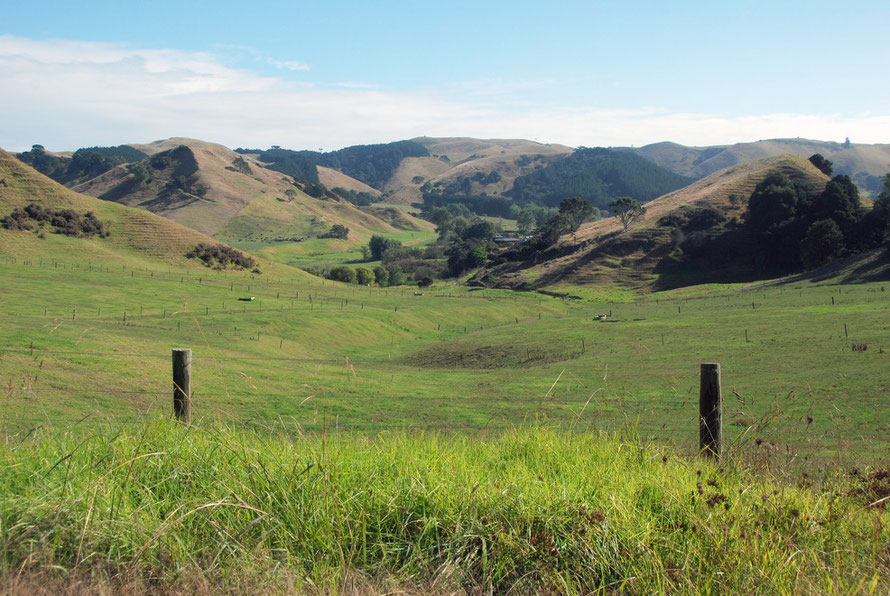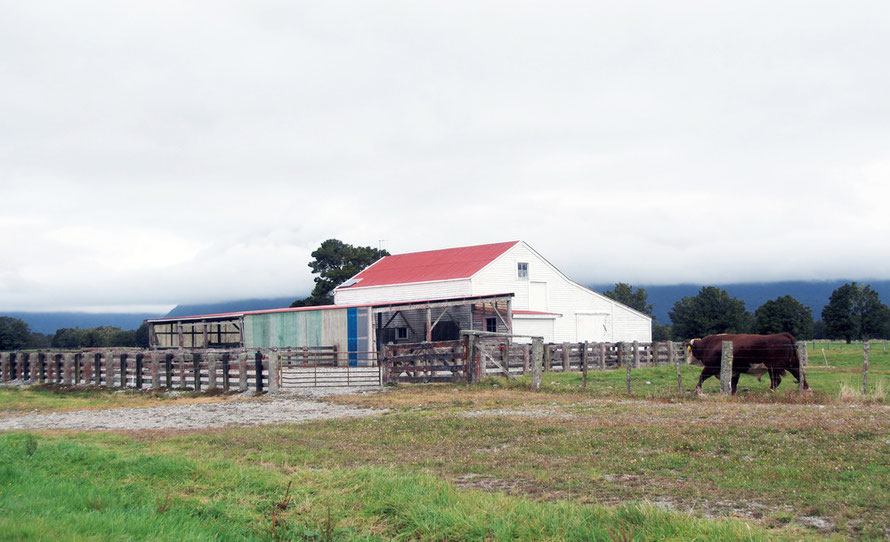V. White Gold: the dairy bonanza
Being a milking man
Ferguson Farms (see my page on this here) was appealing in a whoozy romantic way that has always had a bit of a grip on my soul. But milking twice a day at 5am and 3pm is tough unrelenting work.
I chatted with a US graduate working on a Christchurch dairy farm with 600 milking cows. The guys work seven days on and two days off. Milking is at 5am and 3pm. It shifts to a 16 hour single milking cycle as the cows dry off.
The herd is a Guernsey/Jersey cross for high buttermilk content. It’s a mid-sized dairy farm. The biggest dairy farms get up to 2,000 cows. An experienced milker can milk 600 cows in two hours.
He said it was a hard life, his diet supplemented by the deer his workmates hunt – he swopped liquor for venison. He wonders how New Zealand has been so clever to attract graduates from around the world to come and do their 'grunt work'.
His mother and father look on, aghast that all the education they have bought has led their son to a farm in New Zealand as a dairy hand.
He sits later playing a guitar on the boat to himself, baseball cap still firmly on. He eats with the studied neglect of someone who shuns the manners and everything that he comes from, seeking to ingratiate himself with the other men - the working stiffs.
The guys on the farm hold him at a distance, uncomprehending of this American with an education in their midst, until he shows he too can do the hours and knock back the booze.
There is little room for socialising given the 7 days on 2 days off shift pattern. 'But', he says, 'a Kiwi doesn’t need much excuse to go on the piss every night.'

It is one thing to work as a farmer for local markets and community but another to work to produce the abstracted 'milk solids' that make up the vast quantities of dry milk powder that New Zealand exports to distant markets.
You and your herd and land become a huge input/output machine of increasingly scientific efficiency driven by the profit margins of agri-firms and co-ops supplying machinery, superphosphates, dairy equipment and feed supplements.
One dairy farm looks like another, the denuded cattle-trod and crumbling hills, their milking parlours stuck in fields, the grass a pumped-up nitrogen green, pastures being irrigated, phosphates being airdropped, milk, milk everywhere from Pakiri to Takaka to Lake Bruner (Moana) to the Dunedin Taieri plains and the West coast flatlands.
The land turned into a great milk pump. Although the cattle look in good heart, small breeds without the massive distended Holstein udders of Cornish dairy farms. Sleek even, queuing patiently for milking.
The Great Homogeneity
At first blush and then some, New Zealand’s farms have an air – from the passing road at least - of efficiency – not the ruthless and highly mechanized efficiency of East of England arable farms – but a raw, pared down feel.
There is no quaintness here, no stone farmyards, no succession of buildings over the enduring centuries. The farms lie unannounced by the side of the road and track – 'Cooks Farm' painted on a strip of wood hanging lopsided from a gate, 'Ferguson Farms' under the post box, or simply a postbox big enough to take parcels with a name – 'Fletch & Levers Limited,' (Miranda) and 'A and P Bourke' and a little incised stag's head infilled with white paint (Bullers valley).
Up on the bleak headlands of the Otago peninsula farms are planted on the windswept hill tops – such modest houses – the standard bungalow – with a shelter belt of unruly, exotic pines.
Here and there something larger and more menacing – signs after sign in the broad Waiau River valley south of Te Anau for ‘Landcorp’ – which turns out to be Landcorp Farming – a
State-owned enterprise with 376,942 hectares of leased or owned land and 137 properties.

Mass Production
The premium New Zealand butter in Countdown in Auckland didn’t seem to taste of much. The big blocks and lack of branding made it seem like a commodity rather than a luxury.
And NZ lamb in UK supermarkets has been sold until recently as a mass, undifferentiated meat, although organic lamb is starting to appear and Waitrose has a named New Zealand brand now.
Think of the Anchor Butter packaging - established in 1886 - that has not changed for years and years except to become ‘spreadable’ with the addition of Canola oil. Apparently the recipe has not
changed since being developed by company founder, Harry Reynolds, a Cornish emigre to New Zealand.
Ironically Anchor Butter sold in the UK is no longer made in New Zealand. It is now made with English cream in a Wiltshire processing plant (see
Daily Mail).
Fonterra, the huge dairy production co-operative that dominates the domestic and export market for dairy products was obliged to divest itself of the domestic operations of Anchor Butter by the New Zealand competition authorities.
This occurred after the company's founding merger between New Zealand Dairy Group and the Kiwi Co−operative in 2001. Fonterra then grew a competitor to Anchor built on a South Island brand,
Meadow Fresh Milk, and swapped this with the owner's of Anchor in 2005 to re-assume control of the domestic Anchor brand (see Wikipedia: Anchor).

The Drying Revolution
Marco Polo reported in the 13th century soldiers of the Kublai Khan carrying sun-dried milk. Processing in the 20th century used heated rollers until the 1960s when spray drying after evaporation at low pressure became the norm.
100 litres of whole milk (87% water) produces 13kg of milk powder. In 1993/4 New Zealand exported 450,000 tonnes of milk powder worth NZ$1bn. In the 1990s the variously-owned 14 plants in NZ could process 25 million litres of milk a day (NZ InstChem).

The graph above shows the tripling of dry whole milk production from 1990 (380,00 tonnes) to 2013 (1.27m tonnes). The doubling of production between 2008 and 2012 is particularly impressive - 677,000 to 1.27m tonnes (link to figures by clicking chart above).
In the US dry whole milk production fell from 731,00 to 34,000 tonnes and in Australia production fell from 171,000 to 120,000 between 1982 and 2013.
However in China production rose from 135,000 tonnes in 1982 to 1.22m in 2013 (All stats at InexMundi). There is a danger here in that New Zealand is reliant on low-cost production for middle and low-income countries.
Exclusionary trade practices by North American and European countries, and the high proportions of exports which go to the middle and low income countries, mean that the dairy sector is
constrained to maintain a strategy of low-cost production (see NZAE.org).
In summer 2014 the global price of milk crashed.

Some NZ Dairy Statistics
Dairy cows 5.1m 2014
Whey Milk Power accounts for 40% total production of expected 20.6m tonnes in 2014. In 2014 there were 'extremely high financial margins for WMP' (p.2)
Cheese 320,000 tonnes
Butter 525,000 tonnes
Skim milk power 420,000 tonnes
Infant Milk Formula (IMF) exports were only 3% of total dairy exports at US$320m but, 'it is a high value product and often seen as a model for the future for dairy processing in NZ'. Exports have tripled in the last decade to 33,000 tonnes as prices have tripled.
The whey protein concentrate contamination at Frontera in 2013, 'played badly on the NZ brand image in China' p.3 It will pass and new regulations in China for IMF should benefit reputable suppliers. Longer-term China is beefing up its own IMF production and regulation after the IMF contamination with melamine (see Wikipedia) of domestic supplies (see USDA FAS 2013 New Zealand: Dairy and Products Annual).

Per head and per hectare dairy production increases and stocking rates
In 1993, 653 kg of milk solids were produced each year on average from each hectare of dairy land. By 2012, this had risen to 1,028 kg.
The average cow produced 26% more milk, 28% more milk fat, 33% more protein 30% more milk solids in 2012 than it did in 1996. The average dairy farm stocking rate increased from 2.43 cows per hectare in 1996 to 2.83 cows per hectare in 2012. In 2012, stocking rates varied from 2.18 cows per hectare on the West Coast to 3.44 cows per hectare in South Canterbury
Herd sizes
North and South Canterbury have the largest average herd sizes 710 and 711 cows respectively.
From Note 51-2 'Water quality in New Zealand:Land use and nutrient pollution'

A recent Financial Times article claimed that,
'White gold, as milk is becoming known in New Zealand, is changing the face of the country.'
Since 1980, the dairy herd has doubled to 6.5m cows and sheep numbers have halved. 300,000 hectares of land has been transferred to dairy from other agricultural uses. This has been accompanied by a jump in land prices (an 18.5% increase in the last decade).
Alongside this is an associated boom in capital investment with NZ$1bn dairy plants under construction along with other spin-off infrastructure projects from trucking to port facilities.
See this report, Taranaki Maori, Dairy Industry Changes, and the Crown on
the Taranaki dairy industry produced as part of a Waitangi Tribunal report that looks like it gives a good overview (Chapter 2) of NZ dairy industry development from the 1990s.



